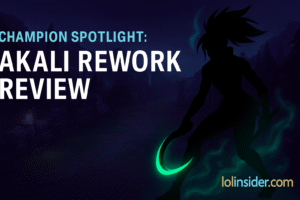League of Legends is a constantly evolving game — but sometimes, Riot Games takes “balance” a little too far. Over the years, we’ve witnessed countless patches where subtle buffs turned into meta-breaking monsters, dominating solo queue and pro play alike.
From unstoppable assassins to unkillable tanks, Riot’s tendency to overbuff champions has become part of LoL’s long-standing identity — a cycle of chaos, outrage, hotfixes, and eventual nerfs.
In this deep dive, we’ll explore Riot’s history of overbuffing champions, why it happens, how it affects the meta, and the most infamous examples that defined League’s ever-shifting balance.
1. What Does “Overbuffed” Mean in League of Legends?
When Riot releases balance patches, champions get buffs (power increases) or nerfs (power decreases). An overbuff occurs when:
- The buff is too strong,
- Multiple buffs stack unexpectedly, or
- The change interacts with other systems (items, runes, or meta shifts) in a broken way.
This leads to one champion skyrocketing in win rate and pick rate overnight, often forcing emergency patches or hotfixes.
2. The Endless Cycle of Buff, Break, and Nerf
The League of Legends balance cycle follows a predictable pattern:
- Underperforming champion gets buffed.
- Players rediscover the champion.
- Win rate explodes across all ranks.
- Riot hotfixes or nerfs them back down.
- Community memes on Riot’s “balancing.”
This “buff → break → nerf → repeat” rhythm has defined LoL since its earliest seasons, keeping the game exciting — and sometimes infuriating.
The real challenge? Balancing over 165 champions across multiple skill brackets, from Bronze to Worlds-level play.
3. Why Riot Overbuffs Champions
Riot’s intentions are usually good — they want to make forgotten champions relevant again. But balance is complex, and small changes often spiral out of control.
Common Reasons for Overbuffs:
- Data Misreads:
Riot uses aggregated win rate data, which can be misleading. A 47% win rate champion may not be weak — just difficult to play. Buffing them risks overpowering skilled hands. - Pro Play Influence:
Riot sometimes buffs champs to encourage diversity in esports. However, pro players exploit even tiny buffs to extreme levels. - New Item or Rune Synergy:
Buffs combined with new systems (e.g., Duskblade, Kraken Slayer, or Mythics) often make certain champions absurdly strong. - Community Pressure:
When players spam “buff my main!” long enough, Riot occasionally caves — and chaos follows.
4. Early Examples – When Riot Created Monsters
Season 3 – Rengar and Kha’Zix Meta
When Rengar and Kha’Zix were buffed back-to-back in Season 3, they created one of the most notorious one-shot metas ever.
- Rengar’s ferocity damage combined with Kha’Zix’s isolation bonus made every jungle invade a bloodbath.
- Pro play banned both for months.
Season 5 – Mordekaiser Rework Disaster
Riot decided to make Mordekaiser the “bot lane juggernaut.”
He gained bonus XP, a dragon ghost, and absurd dueling potential — instantly breaking the game.
- Win rate soared to 70% in low Elo.
- Riot had to hotfix him within days.
5. Modern Examples of Overbuffing Gone Wrong
Aphelios – The Five-Gun Menace
Riot buffed Aphelios multiple times after release because of his steep learning curve.
But once players mastered him, he became a nightmare.
- Dominated pro play for months.
- Riot nerfed him over 20 times.
- Still hovers as a “balancing nightmare.”
Akali – From Stealth to Super Assassin
After her 2018 rework, Akali received multiple small buffs to energy costs and damage ratios.
The result? A champion who could dive turrets, heal endlessly, and 1v9 without counterplay.
- Permanently banned in pro play for over a year.
- Required multiple reworks to fix.
Yuumi – The Unkillable Cat
Initially weak, Riot repeatedly buffed Yuumi to “make her viable.”
The outcome was an untouchable enchanter that made hypercarries like Ezreal and Sivir immortal.
- Her attach mechanic scaled too well.
- Riot eventually reworked her from scratch in 2023.
Irelia – Patch 11.14 Buff Overdrive
When Irelia received base stat buffs in Patch 11.14, she instantly jumped from 45% to 53% win rate.
Her all-in potential and sustain made laning impossible for most matchups.
Riot had to nerf her just one patch later — a classic overbuff cycle.
6. The Mythic Item Era and Power Creep Explosion
When Riot introduced Mythic items in Season 11, balance complexity skyrocketed.
Suddenly, champions interacted with items that amplified their identity, often in broken ways.
Examples:
- Duskblade + Assassins: Made Zed and Talon untargetable, enabling zero-counterplay bursts.
- Kraken Slayer + On-Hit Champs: Turned Vayne and Kog’Maw into raid bosses.
- Goredrinker + Bruisers: Sustained healing made champions like Aatrox and Darius unkillable.
Even when Riot only buffed items slightly, certain champions became unstoppable.
Mythic items magnified every overbuff tenfold — creating a chain reaction across entire roles.
7. When Pro Players Exploit Overbuffs
Professional players are the first to weaponize Riot’s mistakes.
The Aphelios Incident (LCK 2020):
After receiving slight attack speed and damage buffs, Aphelios dominated Korean solo queue overnight.
Pro teams instantly adopted him, leading to:
- 100% pick/ban rate in LCK playoffs
- Riot emergency patching him mid-tournament
The Udyr Renaissance (2021):
Riot buffed Udyr’s movement speed and Phoenix damage.
The result: a 57% global win rate, with pros using tank Udyr to perma-gank lanes.
Sometimes, it’s not that Riot doesn’t test — it’s that pro players find every exploit faster.
8. When Buffs Cascade Across Roles
Overbuffs rarely affect just one champion — they ripple through roles and metas.
Example: Bruiser Buffs = ADC Nerfs
When Riot buffs sustain bruisers like Aatrox, Sett, or Darius, bot lane feels the pain.
Why? They dominate mid and top, forcing ADCs to face tanky comps with no peel.
Example: Jungle Overbuff = Vision Meta Collapse
Buffing champions like Lee Sin or Rek’Sai turns jungle into chaos, where control wards die instantly and laners lose agency.
Each overbuff reshapes the ecosystem of the game, not just one champion.
9. Riot’s Attempts to Fix the Overbuff Problem
Riot has made progress toward more stable balancing, introducing:
- Micro patches (small mid-cycle adjustments)
- Regional data tracking for high vs low elo
- Targeted champion scopes (e.g., “buff weak early game, not total power”)
However, despite data tools and advanced analytics, human interpretation still causes outlier patches.
Balancing is science mixed with art — and sometimes, even Riot paints outside the lines.
10. The Community Reaction – Buff Jokes & Memes
The LoL community never forgets.
Over the years, “Riot buff memes” have become legendary:
- “Riot buffed Yasuo? Guess we’re back in hell.”
- “+5 AD to Viego – see you in Worlds finals.”
- “Akali got a 0.1 AP ratio buff, everyone run.”
Reddit threads and YouTube montages celebrate every “patch explosion,” turning Riot’s balance chaos into part of LoL’s culture.
11. Overbuffing and Power Creep
Each overbuff contributes to power creep — the gradual increase of baseline champion strength over time.
Older champions (like Annie or Garen) feel outdated because new or overbuffed champions do more with less effort.
Riot often solves this by reworking older champs entirely — but the cycle continues:
Buff → Overpower → Nerf → Rework → Buff again.
This is why League’s balance curve never truly stabilizes — it simply shifts.
12. Notable Overbuffed Eras in LoL History
| Era | Overbuffed Champions | Impact |
|---|---|---|
| Season 3 | Rengar, Kha’Zix | Assassin meta domination |
| Season 5 | Mordekaiser, Darius | Juggernaut patch chaos |
| Season 8 | Kai’Sa, Zoe | Burst meta introduced |
| Season 10 | Aphelios, Sett | Pro play dominance |
| Season 11 | Udyr, Seraphine | Mythic item overload |
| Season 13 | Naafiri, Briar | Overbuffed reworks and releases |
13. Why Riot Sometimes Needs to Overbuff
It may sound surprising, but overbuffs sometimes serve a purpose.
- Marketing Impact: A newly buffed or reworked champion attracts attention, boosting playtime and sales.
- Meta Refresh: Strong buffs reset stale metas and force new strategies.
- Testing in Live Servers: Riot occasionally uses live play to collect balance data at scale.
While frustrating, controlled overbuffs can reinvigorate the game — if corrected quickly.
14. The Fine Line Between Buff and Disaster
Riot’s balancing philosophy aims for “rough equality”, not perfect numbers.
But that line between fun buff and game-breaking buff is razor-thin.
Examples:
- +5 base AD on Lucian → skyrocketed into meta dominance.
- -0.25s cooldown on Irelia’s Q → turned her into a reset machine.
- Tiny healing buff on Aatrox → made him a raid boss.
Sometimes, the smallest numbers lead to the biggest problems.
15. Lessons from Riot’s Overbuffing History
- Every buff interacts with the ecosystem.
You can’t buff a single champion in isolation. - Pro play amplifies everything.
A small buff in solo queue becomes devastating in coordinated play. - Community vigilance is instant.
The LoL community spots overtuned changes within hours of patch release. - Balance is temporary, change is constant.
Riot’s approach ensures League never stagnates — even if chaos reigns.
16. Conclusion
Riot’s history of overbuffing champions is part of what makes League of Legends both chaotic and captivating.
From Rengar’s terror to Aphelios’ reign, every patch teaches the same lesson — balance is impossible to perfect, only to pursue.
While players may rage after every “overtuned patch,” these fluctuations keep the meta fresh, the discussions alive, and the game evolving.
League of Legends thrives in its imperfections — and Riot’s overbuffs, for better or worse, are a vital part of that story.







